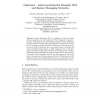JNW
2008
14 years 5 months ago
2008
The use of Instant Messaging, or IM, has become widely adopted in private and corporate communication. They can provide instant, multi-directed and multi-types of communications wh...
CSCW
2002
ACM
14 years 6 months ago
2002
ACM
We examined records of minute-by-minute computer activity coupled with information about the location of the activity, online calendar appointments, and e-mail activity. We presen...
INTERACT
2003
14 years 7 months ago
2003
: One virtue of instant messaging is informality. As messaging is used more in work settings, being able to consult an exchange later can be beneficial. However, archived communica...
ESWS
2008
Springer
14 years 8 months ago
2008
Springer
Instant Messaging (IM) is in addition to Web and Email the most popular service on the Internet. With xOperator we present a strategy and implementation which deeply integrates Ins...
ESWS
2008
Springer
14 years 8 months ago
2008
Springer
Instant Messaging is in addition to Web and Email the most popular service on the Internet. With xOperator we demonstrate the implementation of a strategy which deeply integrates I...
CHI
2008
ACM
14 years 8 months ago
2008
ACM
In this paper, we introduce a prototype system designed to support mobile group socializing that has been appropriated for everyday use by 150 users over 18 months. The system sup...
FC
2006
Springer
14 years 10 months ago
2006
Springer
Although Instant Messaging (IM) services are now relatively long-standing and very popular as an instant way of communication over the Internet, they have received little attention...
ICDCS
2007
IEEE
14 years 10 months ago
2007
IEEE
Instant messaging (IM) has become increasingly popular due to its quick response time, its ease of use, and possibility of multitasking. It is estimated that there are several mil...
CSCW
2000
ACM
14 years 11 months ago
2000
ACM
We discuss findings from an ethnographic study of instant messaging (IM) in the workplace and its implications for media theory. We describe how instant messaging supports a varie...
IUI
2004
ACM
14 years 12 months ago
2004
ACM
One of the limitations in traditional instant messaging platforms is that they predominantly rely on text messages as the primary form of expression. This paper presents FAIM, an ...




